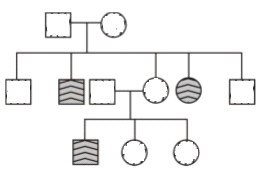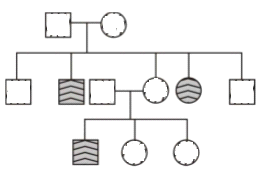Failure of cytokinesis after telophase stage of cell divislon results in an increase in a whole set of chromosomes in an organism and, this phenomenon is known as:
1. Aneuploidy
2. Translocation
3. Polyploidy.
4. Inversion
कोशिका विभाजन के अंत्यवस्था चरण के बाद कोशिका द्रव्य विभाजन की विफलता के परिणामस्वरूप
जीव में गुणसूत्रों के एक पूरे जोड़े में वृद्धि होती है, और इस घटना को इस रूप में जाना जाता है:
(1) असुगुणिता
(2) स्थानांतरण
(3) बहुगुणिता
(4) प्रतिलोमन
जीव में गुणसूत्रों के एक पूरे जोड़े में वृद्धि होती है, और इस घटना को इस रूप में जाना जाता है: (1) असुगुणिता (2) स्थानांतरण
(3) बहुगुणिता
(4) प्रतिलोमन
Which of the following is not a feature of Down's Syndrome?
1. It is caused by a non-disjunction in an autosome
2. The affected individual has trisomy of chromosome 21
3. The aflected individual has a characteristic simian palmar crease
4. The mental development of affected individual is normal
Identify the incorrect statement:
(1) In addition to recombination, mutation is another phenomeonon that leads to variation in DNA.
(2) Chromosomal aberrations are commonly observed in cancer cells.
(3) A classical example of a point mutation is sickle cell anaemia.
(4) Non ionising radiations cannot be mutations.
गलत कथन को पहचानें:
(1) पुनर्संयोजन के अतिरिक्त, उत्परिवर्तन एक और परिघटना है जो DNA में भिन्नता की ओर जाता है।
(2) गुणसूत्री विपथन सामान्यत: कैंसर कोशिकाओं में देखे जाते हैं।
(3) एक बिंदु उत्परिवर्तन का एक उत्कृष्ट उदाहरण दात्र कोशिककीय अरक्तता है।
(4) अनायनकारी विकिरण, उत्परिवर्तन नहीं हो सकते हैं।
Pedigree analysis is resorted to for genetic analysis in humans rather than conventional genetic methods because:
I. Choice matings are not possible
II. Number of progeny is limited
Of the two statements:
(1) Only I is correct
(2) Only II is correct
(3) Both I and II are correct
(4) Both I and II are incorrect
पारंपरिक आनुवंशिक विधियों के बजाय मनुष्यों में आनुवंशिक विश्लेषण के लिए वंशावली विश्लेषण का सहारा लिया जाता है क्योंकि?
I. चयनित संगम संभव नहीं है
II. संतति की संख्या सीमित है
दो कथनो में से:
(1) केवल I ही सही है
(2) केवल II सही है
(3) I और II दोनों सही हैं
(4) I और II दोनों गलत हैं
Match each item in Column I with one item in Column II and chose your answer from the codes given below:
|
Column I Disorder |
Column II Feature |
|
I. Phenylketonuria II. Sickle Cell anemia III. Down's Syndrome IV. Turner's Syndrome |
(i) Rudimentary ovaries (ii) Gynecomastia (iii) Trisomy 21 (iv) Lack of enzyme PAH (v) Lack of tyrosinase (vi) Mutation GAG to GUG (vii) Mutation GUG to GAG |
1. I - v; II - vii; III - iii; IV - i
2. I - iv; II - vi; III - iii; IV - i
3. I - v; II - vi; III - iii; IV - ii
4. I - v; II - vi; III - iii; IV - i
स्तम्भ I में प्रत्येक पद को स्तम्भ II में एक पद से मिलाएं और नीचे दिए गए कूट से अपना उत्तर चुनें:
स्तंभ I स्तंभ II
In a monohybrid cross F1 progeny resemble neither of the parents. What would be true in this case?
1. The parental traits would not appear in any of the F2 -progenies
2. The F2 phenotypic ratio will be different from the F2 genotypic ratio
3. It could be a case of incomplete dominance
4. The F2 phenotypic ratio will be similar to any Mendelian monohybrid cross
एक, एक संकर क्रॉस में F1 संतति के लक्षण माता-पिता से नहीं मिलते। इस स्थिति में क्या सत्य होगा?
- पैतृक लक्षण किसी भी F2 संततियों में प्रकट नहीं होंगे।
- F2 लक्षणप्ररूपी का अनुपात F2 जीनप्ररूपी के अनुपात से अलग होगा।
- यह अपूर्ण प्रभाविता की स्थिति हो सकती है।
4. F2 जीनप्ररूपी अनुपात किसी भी मेंडेलियन एक संकर संकरण के समान होगा।
The two alleles of a gene pair are located on:
1. Homologous sites on homologous chromosomes
2. Heterologous sites on homologous chromosomes
3. Homologous sites on heterologous chromosomes
4. Heterologous sites on heretologous chromosomes
|
जीन युग्म के दो युग्मविकल्पी स्थित होते हैं:
1. समजातीय गुणसूत्रों के समजातीय स्थल पर
2. समजातीय गुणसूत्रों के विषमजातीय स्थल पर
3. विषमजातीय गुणसूत्रों के समजातीय स्थल पर
4. विषमजातीय गुणसूत्रों के विषमजातीय स्थल पर |
Male heterogamety is not seen in:
1. Humans
2. Melandrium album
3. Birds
4. Fruit fly
नर विषमयुग्मता नहीं देखी जाती है:
(1) मनुष्य
(2) मेलैन्ड्रीयम एल्बम
(3) पक्षी
(4) फल मक्खी
The trait shown in the given pedigree chart is most likely a/an:

1. Autosomal recessive trait
2. Autosomal dominant trait
3. Sex linked recessive trait
4. Sex linked dominant trait
दिए गए वंशावली चार्ट में प्रदर्शित लक्षण की सबसे अधिक संभावना है:

(1) अप्रभावी अलिंग गुणसूत्री विशेषक
(2) प्रभावी अलिंग गुणसूत्री विशेषक
(3) अप्रभावी लिंग सहलग्न विशेषक
(4) प्रभावी लिंग सहलग्न विशेषक
Aneuploidy results from :
1. Point mutations
2. Gross structural changes in chromosomes
3. Failure of cytokinesis after telophase stage of cell division
4. Failure of segregation of chromatids during cell division
असुगुणिता किसका परिणाम है:
1. बिंदु उत्परिवर्तन
2. गुणसूत्र में सकल संरचनात्मक परिवर्तन
3.कोशिका विभाजन के अंत्यवस्था चरण के बाद कोशिकाद्रव्य-विभाजन की विफलता
4. कोशिका द्रव्य विभाजन के दौरान अर्धगुणसूत्रों के पृथ्क्ककरण की विफलता






